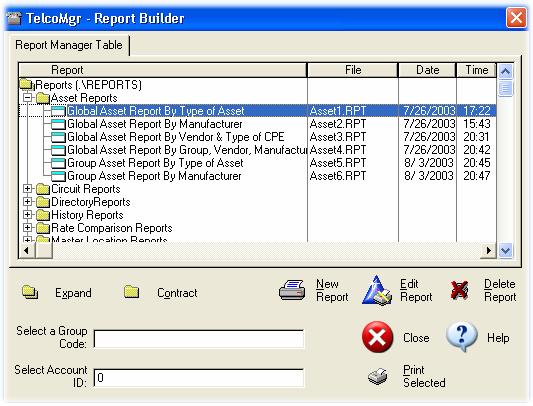Features Of TelcoMgr's Report Builder
Report Builder can do a lot more than simply print columns of data. While that would certainly meet the needs of a lot of users, there are times when specific detail is necessary to accomplish your task. Here is a short list of features you can use:
Accessing/Saving Report(s)
•Tree-styled Report Manager screen will help you to arrange your reports by means of classifying and grouping them by type and using several folders to store report files.
•You can create and manage an unlimited number of reports.

•Quickly create reports that are similar to an existing report by opening a file, then saving the report to a new file name.
•You can use Windows styled long filenames when saving reports.

Caution: Do Not Use the TelcoMgr Report File Names to Save Your Report Changes!
TelcoMgr Report File Names
The TelcoMgr Report Builder will attempt to save your new reports with a name similar to "RPT00001.RPT." The second report that you save will be named "RPT00002.RPT" and the third will be named "RPT00003.RPT" and so on for additional reports. Therefore, end-users are recommended to save report file names using the automatic schema with the built-in serialized report file name.
If you makes changes to one of the TelcoMgr standard reports which are installed with the application, then you should save the changes using "SAVEAS" and let TelcoMgr suggest the appropriate name with the serialized naming schema as described above. If you save your changes with the same name as used by TelcoMgr to store its standard reports, then your changes will be overwritten each time TelcoMgr is upgraded.
Optionally, you may create your own report file names. If you elect to save your reports with your own naming convention, for example "MyTelcoMgrReport01" then it is not necessary to add the ".RPT suffix" at the end of the file name. The Report Builder will append the suffix to your custom file name. Once again, end-users should not use the TelcoMgr report file naming convention to save new or modified reports.
Data Creation/Manipulation
•Simultaneous processing of several data tables joined in an integrated structure
•Effective and high speed filters for records using any available fields from applications database file(s), including expressions and functions of the Report Builder's native programming language
•Sort data using any available fields, including expressions and functions of the Report Builder's native programming language
•You can easily build complex expressions with help of the built in Data Dictionary. The Dictionary contains all the field names, functions, operators, built-in variables and user defined total variables/calculated fields which are allowed for use in an expression. The Dictionary also shares a tree-style hierarchical structure.
•Supports end-user creation of total variables of type Sum, Counter, Average, Minimum, Maximum, Evaluate. Total variables can be reset on the end of appropriate sorting group as well as on the end of each page. These variables can be set up to be evaluated at the start of report, at the each record, at the end of a sorted group, at the end of page, at the end of report.
•Supports end-user creation of "Calculated fields". They are very similar to "Total variables" but always use the Evaluate type and never being reset. You can accomplish very complicated computations using any number of Total variables and Calculated fields.
•Print the current date and time on a page. The Picture can change the format of a date or time field to any desired format. For example, you can change 02/21/00 to read "21 February, 2000" at report runtime.
